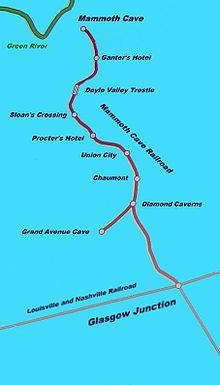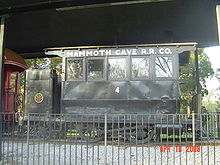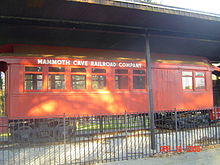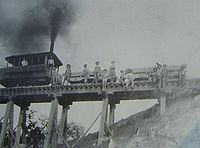- Mammoth Cave Railroad
-
Mammoth Cave Railroad ("Dinkey Train")[1] was a short rail line with a small train off the Louisville and Nashville Railroad (L&N) that went to Mammoth Caves in Kentucky.[2][3] The tiny 9-mile (14 km) railroad[3] from Glasgow Junction (Park City) to Mammoth Caves was started in 1886 and operated for 45 years. The complete Dinkey Train consisted only of a "dummy" 0-4-2T type steam locomotive and a wooden coach to carry passengers and their luggage.[3][4] Among the many stops on the way to Mammoth Caves were Diamond Caverns, Grand Avenue Cave, Procter Cave and Hotel, Chaumont Post Office, Union City, Sloan's Crossing, and Ganter's Hotel.[1] The Dinkey Train could obtain speeds of 25–35 miles per hour on the lightweight rails.[1][3]
Contents
History
Between the ending of the Civil War and 1880 there were about 40,000 to 50,000 passengers annually of the L&N Railroad that stopped off at Glasgow Junction, and then took a stagecoach to Mammoth Caves.[5] Colonel Larkin J. Procter owned and operated this stagecoach line that began at Bell's Tavern. Procter also owned the Mammoth Cave Hotel and estate.
The Mammoth Cave Railroad was not built by the L&N, although it owned the railroad rights to Mammoth Caves. A contract was entered into between two companies whereby the L&N would lease its rights.[6] In 1874 Procter chartered the Mammoth Cave Railroad with his brother George and other investors. They leased the railroad rights to Mammoth Cave from the L&N Railroad. The new railroad acquired four used steam engine locomotives.[1] They were Baldwin "dummy" steam engines formally used on street railways in Memphis and Nashville, Tennessee.[7] They also acquired two wooden passenger coaches and two wooden combination coaches and baggage cars. Usually at any one time there were two sets of Dinkey Trains operating. The coach cars had open vestibules and were heated with a coal stove. They were always painted red.[5]
Before the actual construction work began the L&N agreed to lease the railroad rights to Mammoth Caves for 25 years from the completion of the spur railroad. The actual work on the railroad did not begin until 1880 when the first short part went to Diamond Cave.[5] Construction stopped again until July 1886 when Jim McDaniel and Henry Chapman resumed work on the roadbed.[8] The railroad officially opened for business in November 1886 under this 25 year lease from the L&N. It cost $3 per ticket when it first started running as is recorded in the Mammoth Cave Hotel register on November 8, 1886. The first passenger was a W. F. Richardson.[1] The hotel register reads
“ November 8, Monday, W.F. Richardson, U.S.A., 1st passenger on Mammoth Cave Railroad (Ticket No. 1350) $3.00.[5][9] ” The cost of the entire Mammoth Cave excursion in 1913, including roundtrip railway fare, cave fees, hotel, and meals was $11.75. Also at this time there were additional services that included a side trip to Colossal Cavern for $1.50 and a bed inside a Pullman Sleeper for $1.75 (90 cents each if two occupied the space).[5]
Closing operations
The Mammoth Cave Railroad with the Dinkey Train ran successfully from 1886 until the mid 1890s, after which the L&N abandoned the line. The stockholders then reformed the company under the same name and assumed full control from the L&N in 1903.[5] In 1904 an Indianapolis judge drove the first car to the caves which represented the doom of the railroad line.[5] The establishment of the Mammoth Cave National Park in 1926 put the final nails into the coffin. The Dinkey Train discontinued service February 28, 1929.[5] It was replaced temporarily by a railcar for mail service until 1931 when it finally shut down permanently.[3][5][10] On the first of August 1931 the railroad ceased operations.[1][11]
The Mammoth Cave museum collection at the Mammoth Cave National Park contains Baldwin steam engine number 4 and passenger coach number 2 located at the line's terminus. This display is listed in the National Register of Historic Places as "Hercules and Coach No. 2.[12] The abandoned rail line was converted to the Mammoth Cave Bike and Hike trail in 2004.[13][14] The trail currently starts at Sloans Crossing Pond, however work is underway to have the complete 9-mile (14 km) trail from Park City to Mammoth Cave National Park terminus display of the Dinkey Train at the hotel.[15]
Dummy
The "steam dummy" locomotive filled up with water at Glasgow Junction before it made the 9-mile (14 km) journey pulling the coach up the Chester Escarpment, gaining 200 feet (61 m) in elevation about every mile. The two component train on the spur went through a series of hills and valleys. It would wind its way over a trestle at Doyle Valley and eventually come to Mammoth Cave hotel and estate. The train carried at least a three man crew that consisted of a train engineer to run the locomotive, a boiler man to stoke the engine, and a conductor to tend to the passengers. Many times there were up to seven employees to operate the railroad train. On rare occasions the train pulled additional cars besides the passenger coach. Most famous of the steam engine locomotives was number 4, which was called Hercules.[1][5]
The reason the small steam Baldwin locomotive was called a "dummy" was because it was boxed up to look like a passenger street car.[16][17][18] The idea was to prevent the horses from being spooked when it came close to them. Most times horses are very sensitive to mechanical machines and loud noises.[19] Its condensing engines operated without the noise of escaping steam.[1] It covered the mechanics of the rods, linkage, pipes, bolts, rivets, and most of the moving parts.[19]
The steam engine locomotive was made to look like an ordinary street car for other reasons as well. The mechanics were covered and boxed up in this manner because the raw engine parts were considered to be too brutish to be on city streets. These steam engine locomotives used at the Mammoth Cave Railroad were originally constructed in this "dummy" style by Baldwin Locomotive Works.[19]
Footnotes
- ^ a b c d e f g h Thompson, Bob; Thompson, Judi (2003). Mammoth Cave and the Kentucky Cave Region. Arcadia. pp. 10–16. ISBN 0738515140.
- ^ Herr, Kincaid A. (1964). The Louisville & Nashville Railroad, 1850-1963. University Press of Kentucky. p. 104. ISBN 9780813121840.
- ^ a b c d e Klein, Maury (2002). History of the Louisville & Nashville Railroad. University Press of Kentucky. p. 277. ISBN 0-8131226-3-5.
- ^ "Mammoth Cave steam engine railroad."[dead link]
- ^ a b c d e f g h i j A Little Railroad to a Big Hole in the Ground by Gene Hill[dead link]
- ^ Herr, Kincaid A.(1943). "The Louisville & Nashville Railroad, 1850-1942." L. & N. Magazine. p. 62.
- ^ Butler, William B. (2005). "Railroads in the National Parks." Park Histories. Estes Park, CO: National Park Service. p. 43.
- ^ Diamond Caverns, Park City, KY (2006). "History of Diamond Caverns."
- ^ Mammoth Cave Hotel Destroyed By Early Morning Fire In 1916 written by Bob Thompson (2002) describes Margaret Bridwell's book, The Story of Mammoth Cave National Park (1952) mentioning the hotel register.
- ^ Essex, Stephen (2005). Rural Change and Sustainability: Agriculture, the Environment and Communities. CABI Publishing. ISBN 085199055X.
- ^ Railroad History by Railway & Locomotive Historical Society, p. 36, published 1921.
- ^ Hasting, Philip B. (January 27, 975). "National Register of Historic Places Inventory - Nomination Form: Hercules and Coach No. 2". National Park Service. http://pdfhost.focus.nps.gov/docs/NRHP/Text/75000160.pdf. Retrieved 2009-08-23.
- ^ Mammoth Cave Bike and Hike Trail pictures of bike trail
- ^ Opening Ceremony at Mammoth Cave's new Hike and Bike Trail
- ^ A FalconGuide to Mammoth Cave National Park page 84, written by Johnny Molloy, published 2006 Globe Pequot, ISBN 0762739975
- ^ Rice, Walter; Echeverria, Emiliano (1999). "When Steam Ran on The Streets of San Francisco." Live Steam, November/December 1999.
- ^ Matthias W. Baldwin in 1832 began making of suburban transportation, about fifty years later evolved the "dummy", a steam engine in a box shaped car. The Chicago Daily News Almanac and Year Book for 1885, page 39. Original University of California.
- ^ The Baldwin Locomotive Works have for years been engaged in the manufacture of "dummy" steam engines. from "The Electrical review", p. 39, published 1873 by H. Gillman, 1872-74; Haughton & company, 1875-82; H. Alabaster, Gatehouse & Co. 1882-1919. Original at the New York Public Library.
- ^ a b c White, John H., Jr. (1998). "Dummy Tech: A forgotten world of locomotives in disguise". Invention & Technology (American Heritage) 13 (4). http://www.americanheritage.com/articles/magazine/it/1998/4/1998_4_34_print.shtml. Spring 1998.[dead link]
References
- Sulzer, Elmer Griffith, Ghost Railroads of Kentucky, chapter 21, published by Indiana University Press (1998), ISBN 0-253-33484-5
History of Railroads in Kentucky Companies Frankfort and Cincinnati Railroad · Louisville and Nashville Railroad
Individuals Museums Big South Fork Scenic Railway · Bluegrass Railroad and Museum · Elkhorn City Railroad Museum · The Historic Railpark and Train Museum · Kentucky Railway Museum · Railway Museum of Greater Cincinnati
Stations Ashland Coal and Iron Railroad Office · Ashland Coal and Iron Railroad Store · Chesapeake and Ohio Railroad Passenger and Baggage Depots · Henderson, Louisville and Nashville Railroad Depot · Hopkinsville L & N Railroad Depot · Illinois Central Railroad Station and Freight Depot · Louisville and Nashville Railroad Depot · Louisville and Nashville Railroad Passenger Depot · Louisville, Henderson, and St. Louis Railroad Depot · Old L & N Station · Paris Railroad Depot · Shelbyville L & N Railroad Depot · Stanford L&N Railroad Depot · Union Station (Louisville) · Union Station (Owensboro)
Vehicles Frankfort and Cincinnati Model 55 Rail Car · L & N Steam Locomotive No. 152 · Louisville and Nashville Combine Car Number 665 · Mt. Broderick Pullman Car
Other Barren River L & N Railroad Bridge · Big Four Bridge · Cincinnati Southern Railroad Culvert--CSRR · High Bridge of Kentucky · Lexington Extension of the Louisville Southern Railroad · Louisville and Nashville Railroad Office Building · Mitchellsburg Louisville and Nashville Railroad Culvert · Russell Railroad YMCA · Tank Pond Railroad Underpass
Categories:- 1929 disestablishments
- Defunct Kentucky railroads
- Louisville and Nashville Railroad
- National Register of Historic Places in Barren County, Kentucky
- Railway-related listings on the National Register of Historic Places
- Visitor attractions in Kentucky
- Railway lines opened in 1886
- Standard gauge railways in the United States
- National Register of Historic Places in Kentucky
Wikimedia Foundation. 2010.





